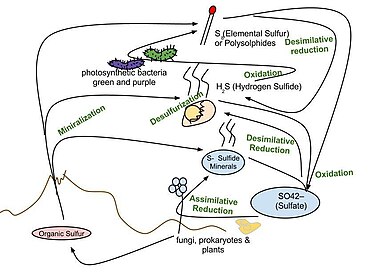
Back دورة الكبريت Arabic Cicle del sofre Catalan Koloběh síry Czech Schwefelkreislauf German Κύκλος θείου Greek Ciclo del azufre Spanish Väävliringe Estonian Sufrearen ziklo Basque چرخه گوگرد Persian Rikin kiertokulku Finnish
This article needs additional citations for verification. (January 2021) |

Sulfur cycle in general
| Part of a series on |
| Biogeochemical cycles |
|---|
 |
The important sulfur cycle is a biogeochemical cycle in which the sulfur moves between rocks, waterways and living systems. It is important in geology as it affects many minerals and in life because sulfur is an essential element (CHNOPS), being a constituent of many proteins and cofactors, and sulfur compounds can be used as oxidants or reductants in microbial respiration.[1] The global sulfur cycle involves the transformations of sulfur species through different oxidation states, which play an important role in both geological and biological processes. Steps of the sulfur cycle are:
- Mineralization of organic sulfur into inorganic forms, such as hydrogen sulfide (H2S), elemental sulfur, as well as sulfide minerals.
- Oxidation of hydrogen sulfide, sulfide, and elemental sulfur (S) to sulfate (SO2−
4). - Reduction of sulfate to sulfide.
- Incorporation of sulfide into organic compounds (including metal-containing derivatives).
- Disproportionation of sulfur compounds (elemental sulfur, sulfite, thiosulfate) into sulfate and hydrogen sulfide.
These are often termed as follows:
- Assimilative sulfate reduction (see also sulfur assimilation) in which sulfate (SO2−
4) is reduced by plants, fungi and various prokaryotes. The oxidation states of sulfur are +6 in sulfate and –2 in R–SH. - Desulfurization in which organic molecules containing sulfur can be desulfurized, producing hydrogen sulfide gas (H2S, oxidation state = –2). An analogous process for organic nitrogen compounds is deamination.
- Oxidation of hydrogen sulfide produces elemental sulfur (S8), oxidation state = 0. This reaction occurs in the photosynthetic green and purple sulfur bacteria and some chemolithotrophs. Often the elemental sulfur is stored as polysulfides.
- Oxidation in elemental sulfur by sulfur oxidizers produces sulfate.
- Dissimilative sulfur reduction in which elemental sulfur can be reduced to hydrogen sulfide.
- Dissimilative sulfate reduction in which sulfate reducers generate hydrogen sulfide from sulfate.
© MMXXIII Rich X Search. We shall prevail. All rights reserved. Rich X Search